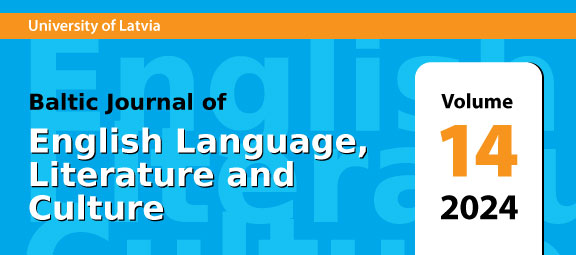Loneliness and Humour in Azi̇z Nesi̇n and Neil Simon: a comparative study
DOI:
https://doi.org/10.22364/BJELLC.14.2024.08Keywords:
humour, loneliness, comedy, Hadi Öldürsene Canikom!, The Odd CoupleAbstract
This comparative study explores how Aziz Nesin and Neil Simon, representing different literary canons, treat and reflect upon the incorporation of loneliness and humour in Hadi Öldürsene Canikom! [Let’s Kill Me Honey!] (1970) and The Odd Couple (1965), respectively. Both playwrights examine the loneliness that has caught urbanised and atomised humans in two metropolises: Istanbul and New York. Simon deals with the values, concerns, lifestyles, aspirations and problems of middle-class people in his plays with domestic realism. In contrast, Nesin’s plays explore lower-working-class people’s values, concerns and struggles. Moreover, it focuses on how Nesin and Simon employ humour, as a Lingua Franca of comedy, in their works. The study emphasises the two playwrights’ incorporation of the humour theories of superiority, incongruity and relief into the selected dramatic texts. The interactions between the characters in the two plays are analysed according to the three traditional humour theories by assuming a discourse-analytic approach. The study has exhibited that in Hadi Öldürsene Canikom, all the humour theories have been explicitly observed. The humour largely stems from a case of mistaken identity, which creates incongruity. On the other hand, in The Odd Couple, humour is primarily evoked due to the incongruous characteristics of the roommates abandoned by their wives.
References
Alberti, F. B. (2019) A Biography of Loneliness: the history of emotion. Oxford: Oxford University Press.
Bergson, H. (1980) Laughter: an essay on the meaning of the comic. In W. Sypher (ed.) Comedy (pp. 61-193) Baltimore: John Hopkins University Press.
Berkowitz, M. G. (2013) American Drama of the Twentieth Century. New York, NY: Routledge. DOI: https://doi.org/10.4324/9781315846729
Bier, J. (1968) The Rise and Fall of American Humour, 1st ed. New York, NY: Holt, Rinehart.
Billig, M. (2005) Laughter and Ridicule: towards a social critique of humour. London: Sage Publications. DOI: https://doi.org/10.4135/9781446211779
Bryer, R. J. & Siegel, B. (2019) Conversations with Neil Simon. Mississippi: University of Press Mississippi. DOI: https://doi.org/10.4324/9781315050256-18
Chanksy, D. (2015) Kitchen Sink Realisms, Domestic Labour, Dining, and Drama in American Theatre. Iowa: Iowa University Press. DOI: https://doi.org/10.1353/book42107
Clark, M. (1970) Humour and incongruity. Philosophy, 45: 20-32. DOI: https://doi.org/10.1017/S003181910000958X
Critchley, S. (2002) On Humour: thinking in action. London: Routledge.
Egri, L. (1960) The Art of dramatic Writing. New York: Simon & Schuster.
Freud, S. ([1905] 2001) Jokes and their relation to the unconscious, In J. Strachey (ed.) The Standard Edition of the Complete Works of Sigmund Freud, Vol. 24. London: Vintage.
Genova, D. (2016). ‘Ha-Ha’ and ‘Really?’ or about the serious in the humourous in the TV comedy show Masters of the AIR. Baltic Journal of English Language, Literature and Culture, 6: 35-46. https://doi.org/10.22364/BJELLC.06.2016.03 DOI: https://doi.org/10.22364/BJELLC.06.2016.03
Hajdu, P. (2019) World drama. Neohelicon, 46: 1-6. https://doi.org/10.1007/s11059-019-00482-5 DOI: https://doi.org/10.1007/s11059-019-00482-5
Hobbes, T. (1840) Human nature. In W. Molesworth (ed.) The English Works of Thomas Hobbes, Vol. 11 (pp. 1-77). London: John Bohn.
Kabacalı, A. (2007) Gözyaşından Gülmeceye Aziz Nesin [From Tears to Laughter Aziz Nesin]. Istanbul: Gürer Publications.
Kulka, T. (2007) The incongruity of incongruity theories of humour. Organon, 14 (3): 320-333.
Morreall, J. (2009) Comic Relief: a comprehensive philosophy of humour. Chicago: Wiley-Blackwell. DOI: https://doi.org/10.1002/9781444307795
Morreall, J. (1982) A new theory of laughter. Philosophical Studies, 42: 243-254. DOI: https://doi.org/10.1007/BF00374037
Nathan A. S. (1958) Modern Literature and the religious Frontier. New York: Harber & Bros.
Nesin, A. (2016) Yol: Böyle Gelmiş Böyle Gitmez — I, Öz Yaşam Öyküsü. [The Road: that is the way he has come, but that is not the way he is leaving — I: An autobiography]. Istanbul: Nesin Yayınevi.
Nesin, A. (1973) Cumhuriyet Döneminde Türk Mizahı [Turkish Humour in the Republican Period]. Istanbul: Akbaba.
Palmer, J. (1994) Taking Humour Seriously. London: Routledge.
Simon, N. (1996) Rewrites: a memoir. New York: Touchstone.
Stott, A. (2014) Comedy, 2nd ed. London: Routledge. DOI: https://doi.org/10.4324/9780203795897
Şekerci, Ö. (2023) Culpeper’s impoliteness strategies in Neil Simon’s Biloxi Blues. Baltic Journal of English Language, Literature and Culture, 13: 125-141. https://doi.org/10.22364/BJELLC.13.2023.09 DOI: https://doi.org/10.22364/BJELLC.13.2023.09
Walden, D. (1980) Neil Simon: toward act III?. Melus, 7 (2): 77-86. DOI: https://doi.org/10.2307/467087
Yüksel, A. (1997) Çağdaş Türk Tiyatrosundan On Yazar [Ten Writers in contemporary Turkish theater]. Istanbul: Mitos Boyut.
TEXTS ANALYSED
Nesin, A. (1970) Hadi Öldürsene Canikom! [Let’s kill me honey!]. Istanbul: Istanbul Matbaası.
Simon, N. (2010) The Odd Couple. New York: Samuel French, Inc.
Downloads
Published
Issue
Section
License
Copyright (c) 2024 University of Latvia

This work is licensed under a Creative Commons Attribution-NonCommercial 4.0 International License.


